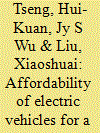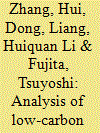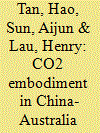|
|
|
Sort Order |
|
|
|
Items / Page
|
|
|
|
|
|
|
| Srl | Item |
| 1 |
ID:
125548


|
|
|
|
|
| Publication |
2013.
|
| Summary/Abstract |
Because Taiwan is an island nation, it is difficult to obtain energy from external power suppliers; therefore, advance planning and scheduling of power development is crucial. This study uses a multi-objective planning method to minimize the cost of power generation and reduce carbon dioxide emissions by decreasing the dual objective of building the power supply scheduling model and the target year. This is conducted according to simulations of future carbon emission reduction policies for the scheduling of power supply situations. The results show that nuclear units will be able to reduce the power generation electricity costs and carbon dioxide emissions effectively; renewable energy has excellent potential to reduce emissions, and the cost of solar power technology with high fossil fuel prices will gradually enhance its cost competitiveness. Gas, although the cleanest fossil fuel, cannot be underestimated for its carbon dioxide emissions. As fossil fuel prices increase, gas will gradually experience a reduction in carbon reduction benefits; integrated gasification combined cycle with carbon capture and storage technology will replace part of the oil and gas power generation, and in addition to the reduction of carbon dioxide and costs, will achieve the goal.
|
|
|
|
|
|
|
|
|
|
|
|
|
|
|
|
| 2 |
ID:
125538


|
|
|
|
|
| Publication |
2013.
|
| Summary/Abstract |
Energy labels in buildings are awarded based on theoretical gas and electricity consumption based on dwelling's physical characteristics. Prior to this research, a large-scale study was conducted in The Netherlands comparing theoretical energy use with data on actual energy use revealing substantial discrepancies (Majcen et al., 2013). This study uses identical energy label data, supplemented with additional data sources in order to reveal how different parameters influence theoretical and actual consumptions gas and electricity. Analysis is conducted through descriptive statistics and regression analysis. Regression analysis explained far less of the variation in the actual consumption than in the theoretical and has shown that variables such as floor area, ownership type, salary and the value of the house, which predicted a high degree of change in actual gas consumption, were insignificant (ownership, salary, value) or had a minor impact on theoretical consumption (floor area). Since some possibly fundamental variables were unavailable for regression analysis, we also conducted a sensitivity study of theoretical gas consumption. It showed that average indoor temperature, ventilation rate and accuracy of U-value have a large influence on the theoretical gas consumption; whereas the number of occupants and internal heat load have a rather limited impact.
|
|
|
|
|
|
|
|
|
|
|
|
|
|
|
|
| 3 |
ID:
125531


|
|
|
|
|
| Publication |
2013.
|
| Summary/Abstract |
This paper compares the economic and environmental benefits of electric and hybrid electric vehicles with that of conventional vehicles. Without tax credits, only the hybrids without plug-in incur lifetime total costs equivalent to a conventional vehicle whereas the consumer affordability for all other vehicles is less encouraging and depends on changes in gasoline prices. With the provision of federal tax incentives, the lifetime total cost for all electric vehicle types that are driven for 120,000 miles over 12 years was found to be generally affordable with no more than 5% higher in lifetime total cost than a conventional vehicle, except the hybrid electric plug-in equipped with a 35-mile electric driving range. Results of sensitivity analysis reveal that a greater lifetime driven mileage would promote further overall cost savings even at a greenhouse gas abatement cost as low as $42 per ton. Our study has demonstrated the importance of an energy policy that includes tax credits to address the inadequacy of cost differentials and consumer affordability. The environmental benefits provided by the electric and hybrid electric vehicles should satisfy consumers' interest in protecting the environment, reducing the dependence on imported fossil fuels, and switching from traditional to alternative fuel vehicles.
|
|
|
|
|
|
|
|
|
|
|
|
|
|
|
|
| 4 |
ID:
125497


|
|
|
|
|
| Publication |
2013.
|
| Summary/Abstract |
While anaerobic digester systems (ADS) have been increasingly adopted by large dairy farms to generate marketable energy products, like electricity, from animal manure, there is a growing need for assessing the feasibility of regional ADS for multiple farms that are not large enough to capitalize their own ADS. Using geographical information system (GIS) software, this study first identifies potential sites in a dairy region in Vermont, based on geographical conditions, current land use types, and energy distribution infrastructure criteria, and then selects the optimal sites for a given number of ADS, based on the number of dairy farms to be served, the primary energy input to output (PEIO) ratio of ADS, and the existing transportation network. This study suggests that GIS software is a valid technical tool for identifying the potential and optimal sites for ADS. The empirical findings provide useful information for assessing the returns of alternative numbers of ADS in this region, and the research procedures can be modified easily to incorporate any changes in the criteria for this region and can be applied in other regions with different conditions and criteria.
|
|
|
|
|
|
|
|
|
|
|
|
|
|
|
|
| 5 |
ID:
125520


|
|
|
|
|
| Publication |
2013.
|
| Summary/Abstract |
This paper quantifies the recharging behaviour of a sample of electric vehicle (EV) drivers and evaluates the impact of current policy in the north east of England on EV driver recharging demand profiles. An analysis of 31,765 EV trips and 7704 EV recharging events, constituting 23,805 h of recharging, were recorded from in-vehicle loggers as part of the Switch EV trials is presented. Altogether 12 private users, 21 organisation individuals and 32 organisation pool vehicles were tracked over two successive six month trial periods. It was found that recharging profiles varied between the different user types and locations. Private users peak demand was in the evening at home recharging points. Organisation individual vehicles were recharged primarily upon arrival at work. Organisation pool users recharged at work and public recharging points throughout the working day. It is recommended that pay-as-you-go recharging be implemented at all public recharging locations, and smart meters be used to delay recharging at home and work locations until after 23:00 h to reduce peak demand on local power grids and reduce carbon emissions associated with EV recharging.
|
|
|
|
|
|
|
|
|
|
|
|
|
|
|
|
| 6 |
ID:
125550


|
|
|
|
|
| Publication |
2013.
|
| Summary/Abstract |
This study discusses the causes of the increase in Japan's energy intensity, defined as energy consumption divided by GDP, since the early 1990s. The significant reduction in Japan's energy intensity ceased in the early 1980s and has even slightly increased since the early 1990s, indicating that Japan seemingly stopped taking aggressive action to improve energy use. However, further analysis at prefecture level and sector level provides additional insight on energy intensity trends. To analyze the causes of the increase in Japan's energy intensity, energy intensity is decomposed into energy efficiency (improvements in energy efficiency) and energy activity (structural changes from the secondary sector to the tertiary sector of the economy). Our result indicates that the non-uniform energy intensity trends between prefectures are attributed to a high variability in energy efficiency. At sector level, we estimate the income elasticity of energy consumption in each sector and find that a structural change in energy consumption behaviors occurred in all sectors at different time points. The industrial sector and commercial sector became less energy efficient after 1981 and 1988, respectively, which is presumably responsible for the deterioration of Japan's energy intensity since the early 1990s.
|
|
|
|
|
|
|
|
|
|
|
|
|
|
|
|
| 7 |
ID:
125659


|
|
|
|
|
| Publication |
2013.
|
| Summary/Abstract |
CO2 mitigation strategies in industrial parks are a significant component of the Chinese climate change mitigation policy, and industrial symbiosis can provide specific CO2 mitigation opportunity. Technology is important to support symbiosis, but few studies in China have focused on this topic at the industrial park level. This research presented a case study in a national iron and steel industrial park in China. Focus was given onto carbon mitigation through industrial symbiosis technology using substance flow analysis (SFA). Three typical iron and steel industry technologies, including coke dry quenching (CDQ), combined cycle power plant (CCPP), and CO2 capture by slag carbonization (CCSC) were evaluated with SFA. Technology assessment was further conducted in terms of carbon mitigation potential and unit reduction cost. Compared with the Business as usual (BAU) scenario, application with CDQ, CCPP, and CCSC reduced the net carbon emissions by 56.18, 134.43, and 222.89 kg CO2 per ton crude steel inside the industrial parks, respectively, including both direct and indirect emissions. Economic assessment revealed that the unit costs for the three technologies were also high, thereby necessitating national financial support. Finally, relevant policy suggestions and future concerns were proposed and discussed.
|
|
|
|
|
|
|
|
|
|
|
|
|
|
|
|
| 8 |
ID:
125598


|
|
|
|
|
| Publication |
2013.
|
| Summary/Abstract |
Using 1997 personal trip survey (PTS) data in the Kumamoto metropolitan area, this paper examined the influence of urban form on energy consumption through an energy estimation model from a microeconomic perspective. As all goods and service are assumed to satisfy the need of people, we estimated the individual energy consumption based on the demand of goods, which is explained by a utility maximization problem constrained by income. 52.84 GJ of energy is estimated for one person one year in Kumamoto metropolitan area. 19.57% of energy is used for mobility goods. A spatial regression was performed to analyze the relationship between energy efficiency and urban form characteristics in terms of density, diversity, and accessibility. The results of regression analysis show that employment density, ratio of employee in retail department, transit fare, and distance to city center are the most influential factors of energy efficiency. Findings suggest compact development and integrated policies for increasing employment density, especially, employment proportion of local residents are suggested. Moreover, measures to improve the attractiveness of mass transit should be encouraged to increase energy efficiency in Kumamoto.
|
|
|
|
|
|
|
|
|
|
|
|
|
|
|
|
| 9 |
ID:
125490


|
|
|
|
|
| Publication |
2013.
|
| Summary/Abstract |
Practitioners from both the upstream oil and gas industry and the space and satellite sector have repeatedly noted several striking similarities between the two industries over the years, which have in turn resulted in many direct comparisons in the media and industry press. The two sectors have previously worked together and shared ideas in ways that have yielded some important breakthroughs, but relatively little sharing or cross-pollination has occurred in the area of asset maintenance. This is somewhat surprising in light of the fact that here, too, the sectors have much in common. This paper accordingly puts forward the viewpoint that the upstream oil and gas industry could potentially make significant improvements in asset maintenance-specifically, with regard to offshore platforms and remote pipelines-by selectively applying some aspects of the maintenance strategies and philosophies that have been learned in the space and satellite sector. The paper then offers a research agenda toward accelerating the rate of learning and sharing between the two industries in this domain, and concludes with policy recommendations that could facilitate this kind of cross-industry learning.
|
|
|
|
|
|
|
|
|
|
|
|
|
|
|
|
| 10 |
ID:
125613


|
|
|
|
|
| Publication |
2013.
|
| Summary/Abstract |
This paper calculates the welfare impact of a new entrant based on the location of entry in the Korean electricity market. We use two different models. One is the optimal fuel mix model to estimate the effect of a new entry in the long run. The other is the variable cost minimization model to assess the contribution of an existing installed private generator in the short run. A specific private generator, which has a cost advantage, saves a substantial amount of system-wide variable costs. We show that the right location for a new entrant can save power generation costs significantly, even if a new entrant does not have a cost advantage.
|
|
|
|
|
|
|
|
|
|
|
|
|
|
|
|
| 11 |
ID:
125595


|
|
|
|
|
| Publication |
2013.
|
| Summary/Abstract |
We have developed a comprehensive model to estimate annual end-use electricity consumption and peak demand of housing stock, considering occupants' use of air conditioning systems and major appliances. The model was applied to analyse private dwellings in Townsville, Australia's largest tropical city. For the financial year (FY) 2010-11 the predicted results agreed with the actual electricity consumption with an error less than 10% for cooling thermostat settings at the standard setting temperature of 26.5 °C and at 1.0 °C higher than the standard setting. The greatest difference in monthly electricity consumption in the summer season between the model and the actual data decreased from 21% to 2% when the thermostat setting was changed from 26.5 °C to 27.5 °C. Our findings also showed that installation of solar panels in Townville houses could reduce electricity demand from the grid and would have a minor impact on the yearly peak demand. A key new feature of the model is that it can be used to predict probability distribution of energy demand considering (a) that appliances may be used randomly and (b) the way people use thermostats. The peak demand for the FY estimated from the probability distribution tracked the actual peak demand at 97% confidence level.
|
|
|
|
|
|
|
|
|
|
|
|
|
|
|
|
| 12 |
ID:
125652


|
|
|
|
|
| Publication |
2013.
|
| Summary/Abstract |
Environmental constraints imposed on hydropower operation are becoming increasingly restrictive. These constraints may reduce the operational flexibility of a hydro plant and therefore its revenue. The objective of this paper is to assess the economic impact of minimum environmental flows and maximum ramping rates on the annual operation of a hydropower plant. For this purpose, a revenue-driven annual optimization model based on discrete dynamic programming and mixed integer linear programming is used. The model considers hourly water inflows and energy prices, limits on reservoir level and water discharge, power generation dependence on the available head, wear and tear costs of hydro units caused by power variations, start-up and shut-down costs of hydro units, and the above-mentioned environmental constraints. In order to show the applicability of the proposed methodology, it is used in a real hydropower plant under five different water year types and 56 distinct combinations of the considered environmental constraints. The results indicate that the revenues of the hydropower plant are very sensitive to the presence and magnitudes of these constraints. Annual losses increase quadratically as a function of the maximum ramping rates and almost linearly as a function of the minimum environmental flows.
|
|
|
|
|
|
|
|
|
|
|
|
|
|
|
|
| 13 |
ID:
125605


|
|
|
|
|
| Publication |
2013.
|
| Summary/Abstract |
There is considerable controversy about the impact of biofuels on food security in developing countries. A major concern is that biofuels reduce food security by increasing food prices. In this paper we use survey evidence to assess the impact of castor production on poor and food insecure rural households in Ethiopia. About 1/3 of poor farmers have allocated on average 15% of their land to the production of castor beans under contract in biofuel supply chains. Castor production significantly improves their food security: they have fewer months without food and the amount of food they consume increases. Castor cultivation is beneficial for participating households' food security in several ways: by generating cash income from castor contracts, they can store food for the lean season; castor beans preserve well on the field which allows sales when farmers are in need of cash (or food); spillover effects of castor contracts increases the productivity of food crops. Increased food crop productivity offsets the amount of land used for castor so that the total local food supply is not affected.
|
|
|
|
|
|
|
|
|
|
|
|
|
|
|
|
| 14 |
ID:
125514


|
|
|
|
|
| Publication |
2013.
|
| Summary/Abstract |
This paper provides new empirical insights on the capital structure of project-financed LNG infrastructures and gas pipeline projects, by using data relating to projects whose financial close occurred between June 2004 and March 2011. Most results are consistent with the basic view of risk-averse funds suppliers. Especially, the projects located in risky countries and larger projects tend to exhibit lower debt ratios and less-concentrated equity ownerships. In addition, regasification projects appear to have a more diluted equity ownership. Methodological issues raised by the financing of these projects are also examined from a capital-budgeting perspective. In particular, the equity residual method, usually used by industrial practitioners to value these projects, should be adjusted.
|
|
|
|
|
|
|
|
|
|
|
|
|
|
|
|
| 15 |
ID:
125602


|
|
|
|
|
| Publication |
2013.
|
| Summary/Abstract |
Despite considerable quantitative case study research on communities living with turbines, few have studied the roles played by the perceptions of: health risk, economic benefits/fairness, and intra-community conflict. We report the findings from a case-control survey which compares residents living with/without turbines in their community to understand the relative importance of these variables as predictors of turbine support. Ontario is the context for this study as it is a place where the pace of turbine installations is both very high and extremely politicized. As expected 69% of residents in the case community would vote in favour of local turbines yet surprisingly, only 25% would do so in the control community. Though the literature suggests that aesthetic preferences best predict turbine support the key predictors in this study are: health risk perception, community benefits, general community enhancement, and a preference for turbine-generated electricity. Concern about intra-community conflict is high in both the case (83%) and control (85%) communities as is concern about the fairness of local economic benefits (56% and 62%, respectively); yet neither is significant in the models. We discuss the implications of these findings particularly in terms of the consequences of a technocratic decide-announce-defend model of renewable facility siting.
|
|
|
|
|
|
|
|
|
|
|
|
|
|
|
|
| 16 |
ID:
125580


|
|
|
|
|
| Publication |
2013.
|
| Summary/Abstract |
This study investigates the causal relationship between clean and non-clean energy consumption and economic growth in Brazil over the period of 1980-2009. Clean energy consumption at aggregated level of total renewable energy consumption and disaggregated levels of hydroelectric, new renewables, and nuclear energy consumption are tested within a production function framework. A cointegration test reveals a long-term equilibrium relationship between real output, capital, labor, and renewable and non-renewable energy consumption at aggregated level, and a long-term equilibrium relationship between real output, capital, labor, and hydroelectric/new renewables/nuclear and fossil fuel energy consumption at disaggregated level. The capital, labor, and new renewables elasticities of real output are positive and statistically significant, other energy consumption item's elasticities are insignificant. The results from error correction model reveal the interdependencies between new renewables, nuclear, fossil fuel, and total non-renewable energy consumption and economic growth, the unidirectional causality from hydroelectric/total renewable consumption to economic growth, the substitutability between new renewables and fossil fuel consumption, and the substitutability between new renewables and nuclear energy consumption. Additionally, nuclear and new renewables energy consumption responds to bring the system back to equilibrium. Overall, aggregated analysis may obscure the relationship between different types of clean energy consumption and economic growth.
|
|
|
|
|
|
|
|
|
|
|
|
|
|
|
|
| 17 |
ID:
125513


|
|
|
|
|
| Publication |
2013.
|
| Summary/Abstract |
We study the contribution of environmental groups to new technology adoption and diffusion by dominant incumbents. Building on institutional and social movement theory, we develop a theoretical framework that sheds light on environmental groups as change-actors. We theorize that by approaching embedded key constituents with various strategic actions, environmental groups affect taken-for-granted beliefs, build legitimacy for renewable energy technologies, and convince skeptical constituents to support the new technology. We verify our theoretical framework with a case study of wind power development in Colorado. We find that environmentalists educate constituents on the benefits of the new technology, engage in activities leading to regulatory and legislative decisions for wind, while also providing direct assistance to the utility. As a result, utilities are both pressured and encouraged to adopt and diffuse wind power on a large-scale. This research directs attention to the role of environmental groups as change-actors and the legitimating effects of their actions. It highlights their part in creating a more favorable institutional environment for new technologies while directly influencing the incumbent?s technology choice. This paper contributes to an understanding of bottom-up, actor-initiated changes in energy systems taking into account both the systemic technological infrastructure and the institutional context.
|
|
|
|
|
|
|
|
|
|
|
|
|
|
|
|
| 18 |
ID:
125650


|
|
|
|
|
| Publication |
2013.
|
| Summary/Abstract |
In this study, we apply the inter-regional input-output model to explain the relationship between China's inter-regional spillover of CO2 emissions and domestic supply chains for 2002 and 2007. Based on this model, we propose alternative indicators such as the trade in CO2 emissions, CO2 emissions in trade and the regional trade balances of CO2 emissions. Our results do not only reveal the nature and significance of inter-regional environmental spillover within China's domestic regions but also demonstrate how CO2 emissions are created and distributed across regions via domestic and global production networks. Results show that a region's CO2 emissions depend on its intra-regional production technology, energy use efficiency, as well as its position and participation degree in domestic and global supply chains.
|
|
|
|
|
|
|
|
|
|
|
|
|
|
|
|
| 19 |
ID:
125554


|
|
|
|
|
| Publication |
2013.
|
| Summary/Abstract |
Since the electricity market reforms of 2002, two large-scale power shortages, one occurring in 2004 and one in 2011, exerted a tremendous impact on the economic development of China and also gave rise to a fierce discussion regarding electricity system reforms. In this paper, the background and the influence scale of the two power shortages are described. Second, reasons for these two large-scale power shortages are analyzed from the perspectives of power generation, power consumption and coordination of power sources and grid network construction investments. Characteristics of these two large-scale power shortages are then summarized by comparatively analyzing the performance and the formation of the reasons behind these two large-scale power shortages. Finally, some effective measures that take into account the current status of electricity market reforms in China are suggested. This paper concludes that to eliminate power shortages in China, both the supply and the demand should be considered, and these considerations should be accompanied by supervisory policies and incentive mechanisms.
|
|
|
|
|
|
|
|
|
|
|
|
|
|
|
|
| 20 |
ID:
125634


|
|
|
|
|
| Publication |
2013.
|
| Summary/Abstract |
This study focuses on CO2 emissions 'embodied' in the characteristic China-Australia bilateral trade, which refer to the CO2 emissions due to the production of goods traded between the two countries. We perform an assessment of the CO2 embodiment in the trade during the period between 2002 and 2010. We find that the scale effect has been a dominant effect contributing to an increase of CO2 emissions embodied in the bilateral trade through the years; while the composition effect seems to be a major driver for reducing CO2 embodiment in the exports of Australia to China. Based on an analysis of the difference between the amounts of actual CO2 embodiment and those in a hypothetical 'no-trade' scenario, we estimate that the 'net' CO2 emissions due to the bilateral trade declined from around 10 Mt of CO2 emissions in 2002 to -10 Mt in 2010; that is, the bilateral trade contributed to a reduction of the global carbon emissions in the recent years. This finding suggests that the rapid growth of exports of carbon-intensive goods from Australia to China has helped in reducing carbon emissions globally because carbon intensity factors of those goods are much lower in Australia than those in China.
|
|
|
|
|
|
|
|
|
|
|
|
|
|
|
|
|
|
|
|
|